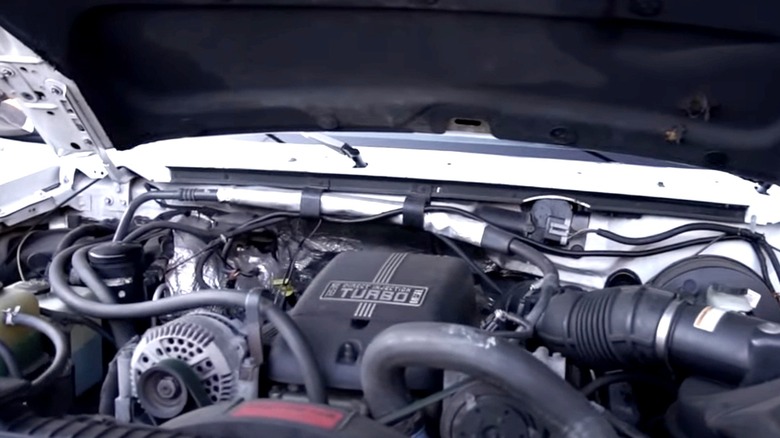How Many MPG Does A 7.3 Power Stroke Get? Here's What Drivers Say
Navistar emerged from the ashes of International Harvester in 1986 and was later snapped up by Volkswagen in 2021. VW has since spun the property off into a new division known as Scout Motors and will reintroduce the Scout as an electric vehicle for the 2028 model year in pickup and SUV forms. But long before it became part of the Volkswagen family, Navistar developed a 7.3-liter turbodiesel engine dubbed the T444E.
By the mid-'90s, Ford was looking for a replacement for its indirect diesel injection 7.3-liter V8 since the one they had maxed out at 190 horsepower, even with the help of a turbocharger. The auto manufacturer brought the Navistar engine into its fold as the Power Stroke 7.3, where it developed a reputation as one of the world's most well-built diesel engines. It first appeared behind the blue oval in 1994's F250 and F350 Super Duty pickups and remained in production through 2003 before new emissions regulations forced Ford to drop it in favor of the new Power Stroke 6.0. Like any other engine, the Power Stroke 7.3 had its up and down years, with camshaft position sensor and wiring harness issues putting a dent in its otherwise stellar reputation in the latter ones.
Early versions produced 210 horsepower and 425 pound-feet of torque, and by the end of its run, the Power Stroke 7.3 was capable of 275 horsepower and 575 pound-feet of torque. For a 1999 F250 Super Duty with the Power Stroke 7.3, Fuelly cites 148 owners as reporting an average fuel economy figure of 14.41 miles per gallon (MPG) over more than three million miles of driving.
Some owners advise keeping engine speed below 2,000 rpm
Those owners reported fuel economy ranging from 7 to 23 miles per gallon, which fits in with figures claimed by Power Stroke 7.3 owners on forums across the internet. That said, opinion is mixed on whether aftermarket tuning chips and other upgrades improve the engine's fuel economy or simply provide more power. Setting that never-ending argument aside, the consensus is that the best way to improve the fuel efficiency of a Power Stroke 7.3-powered truck is to drive conservatively.
In a thread on the Powerstroke Nation forums, Dave7.3 noted, "The aftermarket can only do so much before you have to address the nut behind the wheel. A healthy rig, stock tires and good driving habits will net you the greatest increase in mileage, hands down."
On the r/FordDiesels subreddit, u/BigRed1515 said they were getting about 11 miles per gallon on stock tires while towing a 6,500-pound trailer at 70 miles per hour. u/gonzoforpresident offered a bit of advice, responding, "As soon as you hit 2k rpm, your fuel economy will drop a lot. You can probably pick up a couple mpg simply by dropping your speed to 65." u/texasroadkill agreed, writing, "2k rpm is the sweet spot for these engines." u/drewlyons81 added, "10-12mpg is about all you can really hope for, unless you're crawling around at 50mph."
As expected, towing with a Power Stroke 7.3 reduces fuel economy
u/VanillaGorilla59 noted that how much they haul has a big effect on fuel mileage. They noted that with a cab-over camper in place, "I tip the scales at 11.3-11.7k depending on my load out and I get routinely get 14.5 with a little fuel leak ... Unloaded doing 75-80 I get 20." Matt Barnes of cars.com tested a 2020 F250 with various loads while driving around mountainous areas near Provo, Utah. He calculated that he was getting 14.87 miles per gallon in an empty truck, and 8.4 miles per gallon when towing a 12,500-pound trailer.
In a thread on the forums at Powerstroke.org, Taylorracing noted that they "average 10-13mpg" with their 2002 F350 on 35 inch tires." Forum user Dietoremain had an F250 from the same year with a Super Cab and short bed. They reported that they averaged "14.5 in town, can easily get 20mpg on the highway, running php tunes but have a heavy foot, lol."


